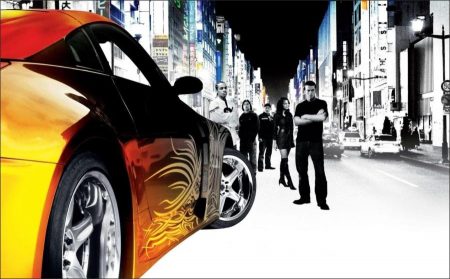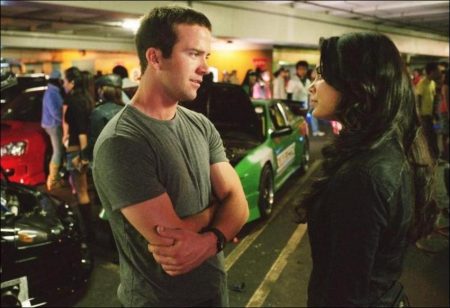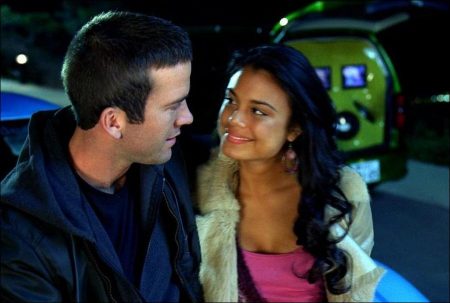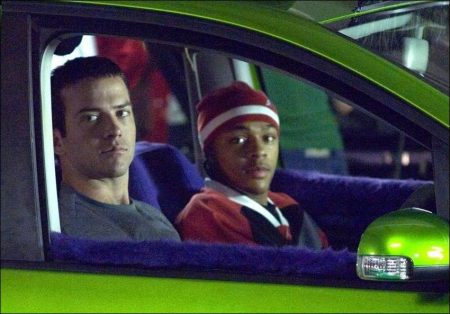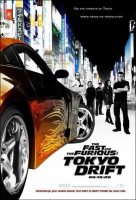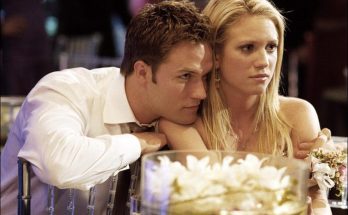On the streets of Tokyo speed needs no translation.
The Fast and the Furious: Tokyo Drift. Chapter one brought to the screen the underground world of American muscle cars and dangerous street racing from the City of Angels. Chapter two told a tale of Miami money laundering, redemption and the latest sleek racers available to men with fortunes to burn. Now, the newest and fastest customized rides go head-to-head on some of the world’s most perilous courses in the latest installment of the adrenaline-spiking series built on speed-The Fast and the Furious: Tokyo Drift.Chapter one brought to the screen the underground world of American muscle cars and dangerous street racing from the City of Angels. Chapter two told a tale of Miami money laundering, redemption and the latest sleek racers available to men with fortunes to burn. Now, the newest and fastest customized rides go head-to-head on some of the world’s most perilous courses in the latest installment of the adrenaline-spiking series built on speed-The Fast and the Furious: Tokyo Drift.
Welcome to the sexy, forbidden and hyperkinetic underground of Tokyo, where the latest trend to emerge from Japan is taking over the world…one drift at a time. Following in the tracks of its predecessors, The Fast and the Furious: Tokyo Drift presents the hottest chapter yet in the popular series that has accumulated more than $443 million at the worldwide box office. Taking racing out of the States and into the post-modern city of Tokyo, Japan, Tokyo Drift brings moviegoers to a sport that simultaneously assaults the senses and delivers daredevil thrills.
Welcome to the tense era of teenage outcasts living in a universe of explosive, white-knuckled street racing, deeply entrenched in Tokyo’s hidden racing scene. Hot cars and sexy girls venture into forbidden territory when drifting is injected in the mix. This distinctly Japanese style of driving defines a new type of driver whose technique must blend effortlessly with daring speed, where control in the realm of no control is more important than crossing the finish line first.
Although street racing provides an escape from an unhappy home and the superficial world around him, for outsider Sean Boswell (Lucas Black, Friday Night Lights), his reckless involvement in the sport has made him very unpopular with the local authorities. After one crash too many-and to avoid jail time-Sean is sent to live with his gruff, estranged father, a career military man stationed in Tokyo.
Now officially a gaijin (outsider), Sean feels even more shut out in a land of foreign customs and codes of honor. But after a fellow American buddy, Twinkie (Bow Wow, Johnson Family Vacation), introduces him to the underground world of drift racing-an exhilarating balance of speeding and gliding through a heart-stopping course of hairpin turns and switchbacks-he’s hooked again, and back in trouble. Simple drag racing is replaced by a new, rubber-burning automotive art form…just bad enough to fit Sean’s rebel style.
On his first time out drifting, Sean unknowingly takes on D.K. (Brian Tee, Fun with Dick and Jane), the “Drift King,” a local champ with ties to the Japanese crime syndicate Yakuza. Sean’s loss comes with a high price tag when he’s forced to work off the debt under the thumb of another ex-pat named Han (Sung Kang, Better Luck Tomorrow). Han soon welcomes Sean into his family of misfits and introduces him to the real principles of drifting. Whether for pink slips, wads of cash or bragging rights, the stakes remain high for Sean and his competition…as they learn to elevate the race itself to an art form. They will take cutting-edge, modified racers to the densely populated streets of Tokyo’s urban landscape at neck-snapping speeds then smoothly glide through tight hairpin turns punctuated by screeches and the acrid smell of smoking rubber.
But when Sean falls for D.K.’s girlfriend, Neela (newcomer Nathalie Kelley), an explosive series of events is set into motion, climaxing with an ultimate high-stakes face-off against his nemesis. Punishment for the loser? Banishment from Tokyo forever by Yakuza crime boss-and D.K.’s uncle-Kamata (the legendary Sonny Chiba, Kill Bill: Vol. 1)…if they survive the race at all. Honor will be challenged and racing skills will be pushed to the extreme…with only one winner standing as champion in The Fast and the Furious: Tokyo Drift.
Controlling the Uncontrollable
In contemplating a return to this world of fast cars and faster attitude, filmmakers behind The Fast and the Furious: Tokyo Drift knew they must retain what was unique about the franchise: misunderstood people on the outskirts of society who are drawn into a world of fantastic cars…a metaphor for losing control in an insane world. For successful filmmaker Neal H. Moritz, producing a third movie in the immensely popular series warranted a fresh take on the car culture of street racers that has continued to intrigue audiences around the world.
Moritz offers, “We didn’t want to do a third in the series unless we had somewhere else to go with the storyline. One day, the idea of Tokyo came up, and the team was discussing that it was the birthplace of this new side of racing called `drifting.’ I thought, `this is something we have to do.’ The results speak for themselves, and I couldn’t be happier with the film.”
He continues, “When we saw underground footage of it, it sparked my interest. It puts you in this trance. You throw caution to the wind. It’s controlled chaos where you’re sliding into turns…you go around corners… taking fenders so close to any object as you glide around it gracefully.”
Vital to Moritz was maintaining the combination of fast-paced action and super-charged riders that established the franchise. The next chapter of the story, set amidst the city’s sexy counterculture where the old rules no longer apply, would need to be told under the direction of a young filmmaker who could deliver pulse-pounding action with a new cast of characters. That man was Justin Lin.
“If we were going to do a third Fast and Furious, it needed to feel fresh,” says Moritz. “After I’d seen Better Luck Tomorrow, I knew Justin was a director I wanted to do business with. He was the first we approached, and…he loved the idea of filming it. This movie needed enthusiasm, and he was the director to do it. Absolutely tireless.”
Recalls Lin, who wasn’t intimately familiar with drifting when approached to helm the project, “I was in film school when The Fast and the Furious came out, and I saw it along with a sold-out crowd who just ate it up. What really excited me about directing this film was the chance to harness that energy-create a whole new chapter and up the ante by bringing something new to the table for the audience who loves action and speed.”
The director knew that if he was going to tackle the project, he had to stay true to the sport of drifting, and the spirit behind it. Lin remarks, “Drifting came about from a working-class group of kids living in the mountains of Japan on really windy roads. They were attempting to find the fastest way to get down these trails. Visually, that’s stunning to observe.”
It was fortunate for Lin and Moritz that they found a screenwriter who was obsessed with the series. Chris Morgan-an avid car enthusiast whose unabashed delight at the prospect of owning, let alone driving, a “wicked short block Toyota Supra that puts out 900 horsepower at the rear wheels”-knew that drifting was a natural fit for the next story in The Fast and the Furious franchise.
Morgan laid out the story for the filmmakers, and a new chapter chronicling the next generation of renegades and the newest models of tricked-out rides was set in motion. “Drifting isn’t about pushing buttons and stomping pedals and holding on. It’s about knowing your car better than the guy who made it. These guys are magicians who take their rides to the very brink of physics, then hold them there, surfing it out on the razor-edge of control. It’s loud and dirty and beautiful. Dangerous as hell, and I fell in love with it the instant I saw it.”
Key to Lin’s approach to the project was to capture an authenticity when it came to the complexities of modern teen life and to create a believable world of young outsiders who live on the edge. The Fast and the Furious franchise has catapulted the careers of its leading men (including Paul Walker, Tyrese Gibson and Vin Diesel). Actor Lucas Black, who starred in the high-school football thriller Friday Night Lights and co-starred in the military drama Jarhead, is set on that same trajectory with his tremendous onscreen charisma and natural acting style.
Moritz relates, “The hallmark of Fast and Furious is to introduce fresh, great actors into the series. And the idea of an outsider anywhere makes for a good story. We brought Sean and the concept to Tokyo to have him as a fish out of water that falls into this underground world. I had seen Lucas in Slingblade, Friday Night Lights and Jarhead and thought he was an incredible actor who fit this movie we wanted to make.”
The 23-year-old actor, who was coming off back-to-back dramas, wryly admits that his initial excitement, upon hearing the filmmakers were interested in him for the lead role, was all about working around fast cars. The character of renegade Sean Boswell would have to take a back seat.
“The decision was pretty easy. It’s The Fast and the Furious series; it’s all about the action and the cars,” remarks Black. After reading the script, however, he found the character of Sean Boswell, a true renegade with a predilection for street racing, provided as much enticement as the cars could-another welcome challenge for the actor.
Lin knew he’d need a lead with the kind of enthusiasm (and skills) Black could show. “Lucas really knows how to drift now. I think he and Brian [Tee] had a field day out there. They were able to go out onto the Speedway and not worry about having to swap out tires every 20 minutes. I think that really shows in their performance.”
Recording artist-turned-actor Bow Wow was looking to take a break from his recent work co-starring in a string of family comedies (Johnson Family Vacation and Roll Bounce) and mix it up on the set of The Fast and the Furious: Tokyo Drift. He found that in the hustler character of Twinkie. “I loved the character,” Bow says. “Twinkie is so smart and has fun-whether he’s hustling in Harajuku, kickin’ it with the girls in the club, or chillin’ with his friends. Underneath it all…it’s business, and he knows what he’s doing.”
From 21-year-old Australian beauty Nathalie Kelley, who makes her feature film debut in Tokyo Drift, to Brian Tee cast as Sean’s archrival D.K.-Tokyo’s reigning king of drifting-Lin and Moritz felt it vital to tap into fresh new talent for each key role of the film.
“We needed a fresh-faced actress who could hold her own against all these tough guys,” remarks Lin. “I found that in Nathalie… when she’s on screen, you can’t take your eyes off her.”
Recalls Moritz, “We wanted truth with D.K.’s character. He starts very adversarial with Sean. We found actor Brian Tee, who happens to be the sweetest guy, but looks so tough on screen. As soon as we saw him come in with that face and those muscles…he was our D.K.”
The filmmakers further assembled an eclectic ensemble cast including Sung Kang and Jason Tobin, who previously collaborated with the director on his critically acclaimed directorial debut Better Luck Tomorrow. Also joining the cast are Leonardo Nam, Japanese actress Keiko Kitagawa, Zachery Ty Bryan and Nikki Griffin-providing an international flavor to the production.
For Kang, transitioning from a low budget independent with Lin to a big budget summer release was a bit surreal. “Beautiful cars, beautiful women, beautiful locations,” he explains with a grin… “I thank Justin every day. We went from an independent feature to a big studio project. It’s a world of difference, and it’s nice that you can share it with friends.”
Anchoring the youthful cast with a healthy dose of gravitas is Sonny Chiba-the ’70s martial arts powerhouse and star of the cult classic The Street Fighter-as D.K.’s menacing uncle/Yakuza boss Kamata.
Recounts Lin, “One of the highlights for me is getting to work with the legendary Sonny Chiba. When we began prepping this film, it was very important for us to cast the role of Kamata with someone who has that iconic value, but also the presence and strength as an actor.”
With only two cast members fluent in Japanese (Kitagawa and Chiba), and fewer aware of the burgeoning phenomenon of drifting, Lin knew he had to be meticulous in his research and education. He subsequently developed the curriculum for his young cast of actors to prepare for their roles.
Lin made sure his team was immersed in all aspects of the underground culture. He recruited the film’s U.S. technical consultant, Toshi Hayama, to inform the production, and even based the character of drift purist Virgil on numerous conversations with Hayama-promising not to dilute the art form Hayama loved. Lin also gave his students Japanese language lessons replete with Tokyo slang and intense drift training sessions.
Depending upon the cast member, it was either learning the nuances of the Japanese language, or sitting behind the wheel of a $50,000 tuner car and hitting the gas pedal, that made for his or her favorite rite of passage in preparation for shooting.
Training day in the controlled environs of a local Southern California speedway was comprised of ride-a-longs with the film’s drift drivers Rhys Millen, the current U.S. Formula Drift Champion, and the film’s fellow drift racing stunt driver Tanner Foust. To the delight of the actors, there was even a chance to burn their own rubber in the driver’s seat.
Recalls Black, “When they took us to the racetrack for the first time and showed us how to drift…man, it was awesome. I was addicted. I was more comfortable in the driver’s seat than I was in the passenger’s seat. Even if it was Rhys driving, there were still some trust issues as you’re spinning out with the G-forces slamming you.”
Adds Tee, “I’m an adrenaline junkie, so when they gave me the keys to the Z (the ’02 Nissan Fairlady 350Z) and said, `Burn as much rubber as you want,’ I was all over it. They had to kick me off the track.”
It paid off, particularly for Black, who admits that he moved naturally and with surprising ease, whether punching the accelerator at the precise moment or easing into slide when filming his driving sequences.
Prior to filming Tokyo Drift, Kelley-who like Bow Wow-only knew how to drive an automatic (and recently earned her driver’s license), gamely took on the simultaneous task of learning how to use a stick shift, timing her braking and understanding the art of drifting. Ironically, as much as the guys eagerly embraced their instruction on the art of the drift, it was Kelley-as the lone female on the track-who executed the difficult driving style and drifted as effortlessly as her character, Neela. A proficient drifter who utilizes the organic, Zen approach to the sport, Kelley chalks it up to the fact that she listened. The actor notes, “I paid attention, because I understood going in that I knew nothing about the sport. Whereas, some of the boys got a bit cocky and decided to take things into their own hands…”
Hello, Ladies: Drifting Hot Wheels in Tokyo Drift
The Fast and the Furious allowed film audiences their first entrée into illegal street racing, and 2 Fast 2 Furious gave a whole new glimpse into the world of hot cars and explosive tempers. The Fast and the Furious: Tokyo Drift follows suit with its exposé of the bone-jarring sport of drifting. Drifting originated on the multiple mountains and canyons of rural Japan when young drivers, usually driving late at night, sped along the dark roads with the tail ends of their cars sliding through cliffside turns.
Word of the endorphin rush felt by drifting aficionados soon escaped into the local street racing scene and, eventually, the progressive driving style was exported outside the island nation, and seeded throughout the United States and Europe to become the next trend in sport driving.
Almost 15 years ago, Keiichi Tsuchiya, the drifto emeritus of Japan’s racing community and the supervising technical consultant on The Fast and the Furious: Tokyo Drift was the first to incorporate and perfect drifting into his driving style on Japan’s race circuit. Subsequently, he earned back-to-back championship titles and the enduring sobriquet of Drift King.
“We have the best tech people working on this,” says Moritz. “Our visual effects guys are the same from the first two films. They all know that we have a code for this series: We don’t want the cars to do anything they can’t do naturally. The team has just done a terrific job lending the credibility we needed.”
Beyond the physics of drifting, it was up to Hayama, whose roots lay deeply imbedded in Japan’s street racing culture, to advise the filmmakers on a multitude of arenas of Japanese culture. From car selections to driving slang to music, the racer comments, “I’m a car guy at heart. It’s an exciting time…everything about the drifting culture is still evolving. To me, drifting is taking a car-whether it’s a Japanese, American, German sports car or four door-and breaking all the rules about what it’s supposed to do. You’re building it so it loses traction on the rear tires, then driving sideways into turns at speeds up to 100 mph, with those tires spinning and smoking…it’s incredible.”
While driver skill surely plays an important part in drifting, how the car is built is equally as vital to the drift. The racecar is basically rebuilt to enhance a driver’s style and technique, creating a perfect balance between man (or Neela) and machine. When coming into a turn at incredibly high speeds with tires smoking and rpm’s revving, it’s essential that a drifting car is fine-tuned to its handler, so every specification can be pushed to the limit.
When it came to finding the team to translate the mind-blowing moves from the set to the camera, the filmmakers went to internationally-known pro drift drivers Millen, Foust and Samuel “The Crazy Swede” Hubinette, along with top-ranked Japanese drifter Nobushige Kumakubo and Tsuchiya. While filming on the mountains outside of Tokyo, Tsuchiya got behind the wheel of a car to choreograph a stunning cliffside two-car tandem drift sequence with Kumakubo.
Filming the drivers in action proved to be more exciting than expected for both Lin and director of photography Stephen Windon. They employed a number of specialized rigs (a mobile camera-rigged Porsche Cayenne and Mini Coopers) but also capitalized on the ability of Millen, Foust and Hubinette to repeatedly hit their marks-while handling over 3,000 lbs. of skidding and screeching metal. For Lin and Windon, they now had the luxury of designing precise and complicated camera shots.
“Drifting is a very cinematic sport,” relates the director. “It’s exciting to do something that’s never been done before on film. It’s amazing to me how we’ve found new angles and new camera moves to capture the action. These drivers are so good and so precise, we were able to come up with new ideas on how best to capture it.”
“It was fantastic,” recalls Black. “A couple of times I’d sneak off and drive between shots. Just don’t tell anybody,” he laughs.
It was up to the 50-man crew-all with their own specialties-to maintain every aspect of upkeep for the cars. From gassing them to replacing a burnt-out clutch on a moment’s notice to ensuring that every car would exceed expectations, the crew accomplished whatever Lin and his cadre of drivers envisioned.
Accustomed to seeing the pricey modifieds cut graceful, smoky arcs, Hayama cringed at the destruction inflicted upon his racers-particularly for one of the first and more visually challenging drift races held inside a multi-level parking garage structure.
He grimaces, “It broke my heart to see those Silvia S-15s (Sean Boswell’s introduction to drifting car) crashing, but it’s all in the name of great drifting action, right?” The result, however, was an eye-popping race sequence, which unfortunately demolished a total of seven Nissan Silvia’s-Hayama’s drifting ride of choice.
For Dennis McCarthy, who oversaw all aspects of maintaining every car featured in the film, it was necessary to carve up many of the cars to secure intricate camera angles-resulting in in-your-face action for the audience. “We literally cut up 25 cars and destroyed over 80. The cars we cut were either chopped in half, had their roofs taken off or had one of the sides sliced,” says McCarthy.
The filmmakers wanted to raise the stakes when it came to their new cast of cars. Not wanting to duplicate the hundreds of dazzling and unique automobiles showcased in The Fast and the Furious and 2 Fast 2 Furious, they utilized the tried-and-true method of an open casting call. Once again, the event boasted a record turnout of proud owners showcasing the next generation of customized eye candy for the filmmakers (and other race enthusiasts) to admire.
Import tuner cars and all cars fast and furious remained in the mix, but the producers now focused their attention on the fantastic rear-wheel modifieds that would initiate newbies to drifting. When all was said and done, close to 250 vehicles were used throughout filming in the U.S. and Japan.
A sizable chunk of the film’s budget went toward assembling a selection of right-side driving Japanese imports for the film’s principal cast to roll with. Modified by some of Japan’s top tuners, each of the main vehicles required multiples (from three to eleven per car) to handle the filming needs-plus the punishment that the drivers were meting out on a daily basis.
The red Mitsubishi Evolution 9-universally known as the EVO-was converted for drifting, courtesy of Millen and his team of mechanics who helped modify a number of cars to accommodate the needs for the drifting sequences.
The car of choice for D.K. and his cohorts (aptly named the Tea-Hairs for their bleached tea-colored hair), the ’02 Nissan Fairlady 350Z, channeled the style and substance needed for Tokyo’s top thug drifters. Whether decked out in one-of-a-kind graphics-an intricate scarab for D.K.’s gray-on-black model or the tribal design emblazoned on Morimoto’s black-on-gold Z-the model surpassed everyone’s expectations when it came to performing. D.K.’s 350Z, decked out with a mind-blowing twin-turbo engine, along with its 12 sisters, took the brunt of the action over the course of filming. From drifting in most of the film’s balls-to-the-wall race sequences to speeding full-throttle through the streets of Tokyo, it held up to the rigors of what the filmmakers envisioned. The result was original, highly stylized action.
No car defines its owner more than the orange/black ’94 VeilSide Mazda RX-7 driven by Han, the drifting patron to the ingénue Sean. With a customized body kit by VeilSide, a top Japan-based car customizer, the showpiece-along with its five identical clones-offered a much more sophisticated take on the high-performance tuner cars of the film. She also melded perfectly with Han’s casually hip persona.
Kelley felt her character’s car was the perfect complement to her character, a gaijin with a singular style. “Neela’s car is an Mazda RX-8, and you definitely wouldn’t expect a girl to drive it. It’s a serious car that can do some serious drifting,” the actor reflects. “We didn’t want something that was too obvious for her, because a drifter’s car is a true reflection of the driver and Neela is not a prissy girl. She races with the boys and can hold her own in the car and out of it.”
Rounding out the supporting roles of the film-comprising a who’s who of drifting dream cars-were multiple models of Nissan Silvia S13s and S15s, a Toyota Chaser and a Nissan Skyline R33.
Not to be outdone by the modified, super-charged imports, American muscle cars make their presence quite well-known in the film. From the classic beauty, a ’69 Mustang-which houses an unorthodox choice of a Skyline GTR engine-to the newest looker on the block, an ’05 Dodge Viper, America represents. Beauty is definitely in the eye of the beholder with Sean’s two-toned, primer-covered ’71 Chevy Monte Carlo, which masks a stunningly powerful engine under its hood. The Chevy opens the film, and it is the reason he gets the boot from America.
Also joining the elite group of cars in The Fast and the Furious: Tokyo Drift is a German import: Volkswagen’s newly released Touran van. Tokyo’s underground car scene boasts multiple subcultures, all dedicated to every make and model of car, motorcycle, truck and van. The filmmakers, naturally, wanted to include a part of it in the film. The sleek van, driven by the comic-book-loving hustler Twinkie, was tricked inside and out into a hulking, pimped-out, party wagon with a bass-thumpin’ state-of-the-art multimedia system.
“This,” the Touran’s driver Bow Wow points out, “is not your average van. The sound system alone probably weighs more than some of the cars we’re using. I always have the music blasting in this thing.”
Post-Modern Western: Design of the Film
Director Lin was precise when it came to setting the visual stage to film the landscape of Tokyo Drift. He knew it would be difficult to capture the complex street-racing subculture that surrounds drifting and the modern, global city that envelops it. “The Tokyo you see in the film is definitely my take on the city. It hits you on different levels. I wanted to created a wild, wild west where people express themselves to the extreme…whether it’s how they dress or what they drive.”
The filmmakers’ vision required exacting attention to detail from their production team of Windon, production designer Ida Random and costume designer Sanja Milkovic Hays. For Random, that challenge initially lay in creating a seamless look that could transition from the waterfront docks of San Pedro, California, and the Los Angeles suburbs to the stark, rustic, winding roads that snake through the hills of the city’s Griffith and Elysian Parks. These hills would provide the backdrops for several breathtaking cliffside races set on the outskirts of Tokyo.
Random and her team recreated Tokyo’s Shibuya district in the midst of the urban sprawl of downtown Los Angeles. The filmmakers accomplished an extraordinary effort by closing six full city blocks to film a chase scene-taking two film units almost two weeks of filming to complete. Street signs, buildings, newsstands, restaurants and bus stops replete with Japanese kanji to identify them were splayed over three city blocks. Ironically, this would create a bit of confusion among a group of Japanese tourists who stumbled upon the filming set.
While Los Angeles provided the team the versatility to recreate Japan’s largest city in the Southland of California, they knew they couldn’t completely duplicate the vitality that makes it one of the most unique cities in the world. Lin and Moritz agreed early on that filming in Tokyo would be essential to further establish the authenticity of the urban landscape. From the neon-saturated districts of Shibuya and Shinjuku to the gritty working-class neighborhoods and winding mountainside roads of Chiba (located several hours outside Tokyo), the filmmakers wanted to take a multifaceted snapshot of one of the world’s oldest-yet most modern-cities.
Producer Moritz notes, “It was important for us to feel like we could go shoot anywhere we wanted in Tokyo. By bringing in a smaller crew, getting in there and making it happen, no one who looks at this movie will think we weren’t there for the entire shoot.”
The opening sequence of the film, the only one set in the States, had the cast and crew spending close to a week on the dusty flatlands of Victorville, located 86 miles east of Los Angeles. The scene, which kick-starts the action in The Fast and The Furious: Tokyo Drift, has Black’s high-school loner Sean going head-to-head against the school’s blowhard football quarterback.
Following several months of filming in Southern California and a brief Thanksgiving holiday break, cast and a partial crew comprised of two separate film units traveled to Tokyo for four weeks to film exterior scenes.
Amidst the chaos of filming in the heavily populated city where officials and citizens are unaccustomed to hosting large film productions, Lin quickly reverted to his origins as an indie filmmaker. He relished the opportunity to plant an actor (Black) in the center of the kinetic Shibuya, the “Time Square of Tokyo,” with a camera (mounted on Windon’s shoulder) and just start shooting. Similar filming styles followed at other familiar landmarks such as Tokyo Tower, Rainbow Bridge and the teen fashion center Takeshita Dori near Harajuku.
Recalls Lin, “We ended up shooting guerilla style around the city and grabbing whatever we could. It was great for me, because it reminded me of all the independent films that I made where we were running and gunning and going with your gut…it was a lot of fun.”
The actors took it all in stride, but definitely found living and working in a very different culture an adjustment. Says Southern-born Black, “Coming from a small town in Alabama, I never thought I’d visit a city like Tokyo. It’s a humongous city with lots of people…it was cool to live and work in this new culture, but I got homesick quickly,” he remarks.
Equally important to capturing the Tokyo zeitgeist was tapping into the style of a city known for co-opting music, fashion, cars and style from American and European culture…and making it her own by deconstructing and reinventing it. The director offers, “Tokyo is a place where they rebuilt the city, and it has taken a little bit of everything from around the world in its reconstruction.”
Costume designer Sanja Milkovic Hays, a frequent collaborator with Moritz, accepted the challenge of raising the bar she established with trendsetting looks for the previous The Fast and the Furious films to visualize the quirky, often intangible fashion sense of the pop-culture-worshiping Tokyo youth. “I started looking at Japanese fashion magazines for the first Fast and Furious, because they are so forward in street fashion. With this film, I’m able to fully push the envelope,” she remarks.
From teen girls clad in sexy Victorian-inspired Gothic Lolita garb, the lacy-white-adorned Bo Peep personas to the Rockabilly, Mods, Punks and Hip-hop wannabes hanging out at Harajuku Station, Hays took the avant-garde looks and amped them to rival the fast cars of the drifting culture. At times, while filming at the pseudo fashion runway of Takeshita Dori, it was often difficult to discern Hays-garbed background actors from the regulars taking their afternoon strolls.
The soundtrack for the film was as much an eclectic blend as the other aspects of Tokyo Drift’s production and design. Songwriters and performers from Pharrell Williams and Kid Rock to the Teriyaki Boyz, Shonen Knife and Mos Def contributed to the sometimes frenetic, sometimes soulful music that follows Sean’s journey from the streets of Los Angeles to Tokyo. For example, with former Guns ‘N Roses guitarist Slash performing on “Mustang Nismo” and “Welcome to Tokyo,” the blend of Far East and Western culture can be felt throughout the soundtrack.
Introducing the sexy, high-octane style of drifting into the mix was something the filmmakers knew would excite moviegoers and car buffs who like their cars fast and their culture furious. Attention to detail, coupled with inventive, mind-blowing action and a fresh new cast of characters ensures that this installment will enthrall the second an audience member’s foot hits the gas, the minute he shifts gears, and the instant she slams the emergency brake. In The Fast and the Furious: Tokyo Drift, movie lovers will feel the rush of screaming through a corner to hit 75 mph… and experience an assault on their senses they haven’t felt in, well, three years since the last film.
From the Producer
I am thrilled to be continuing “The Fast and the Furious” franchise. It is so exciting to be able to introduce car fans to a whole new style of racing: drifting. Tokyo is the birthplace of drift racing and preserving the authenticity of this world was of the utmost importance to us.
As in the first two movies, the cars are really the stars of the film. We custom built all of the cars we used under the guidance of real legends within the drift race world, and had actual D1 racers drive for us. The nonstop action they create, combined with the vibrant landscape of Japan, is electrifying to see on screen.
Working with newcomers to the franchise, stars Lucas Black and Bow Wow, further distinguishes this film as a stand alone, adrenaline-packed blockbuster not to be missed. I am so proud of the movie and can’t wait for you to experience the dynamic thrill ride of Tokyo Drift! – Neal H. Moritz, Producer.
The Fast and the Furious: Tokyo Drift (2006)
Directed by: Justin Lin
Starring: Bow Wow, Lucas Black, Brian Tee, Nikki Griffin, Sung Kang, Jason Tobin, Nathalie Kelley, Leonardo Nam, Amber Stevens West, Brandon Brendel, Ashika Gogna, Nikki Griffin
Screenplay by: Chris Morgan, Kario Salem
Production Design by: Ida Random
Cinematography by: Stephen F. Windon
Film Editing by: Kelly Matsumoto, Dallas Puett, Fred Raskin
Costume Design by: Sanja Milkovic Hays
Set Decoration by: Douglas A. Mowat
Art Direction by: Tom Reta
Music by: Brian Tyler
MPAA Rating: PG-13 for reckless and illegal behavior involving teens, violence, language, sexual content.
Distributed by: Universal Pictures
Release Date: June 16, 2006
Views: 84
